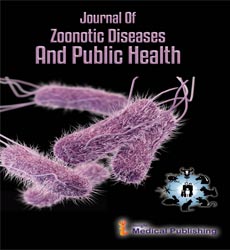Study of Salmonellosis and Ebola Virus
Jens Kuhn*
Department of Clinical Sciences, Liverpool School of Tropical Medicine, Liverpool, UK
- *Corresponding Author:
- Jens Kuhn
Department of Clinical Sciences,
Liverpool School of Tropical Medicine,
Liverpool,
UK,
E-mail: jens.kuhn983@mch.uk
Received Date: July 02, 2021 Accepted Date: July 16, 2021 Published Date: July 23, 2021
Citation: Kuhn J (2021) Study of Salmonellosis and Ebola Virus. J Zoonotic Dis Public Health Vol.5 No.4:e002.
Editorial Note
HIV was a zoonotic sickness communicated to people in the early piece of the twentieth century; however, it has now transformed into a different human-just infection. Most strains of flu that contaminate people are human illnesses, albeit many strains of bird influenza and pig influenza are zoonoses; these infections infrequently recombine with human strains of this season's virus and can cause pandemics like the 1918 Spanish influenza or the 2009 pig influenza. Taenia solium contamination is one of the dismissed tropical sicknesses with general wellbeing and veterinary worry in endemic locales. Zoonoses can be brought about by a scope of illness microorganisms, for example, new infections, microbes, growths, and parasites; of 1,415 microbes known to contaminate people, 61% were zoonotic. Most human infections started in creatures; notwithstanding, just illnesses that regularly include non-human to human transmission, like rabies, are viewed as immediate zoonosis.
Zoonoses have different modes of transmission. In direct zoonosis, the infection is straightforwardly sent from creatures to people through media like air (flu) or chomps and salivation (rabies). Conversely, transmission can likewise happen by means of a moderate species (alluded to as a vector), which conveys the illness microorganism without becoming ill. At the point when people contaminate creatures, it is called switch zoonosis or anthroponosis "infection".
Host hereditary qualities assumes a significant part in figuring out which creature infections will actually want to make duplicates of themselves in the human body. Risky creature infections are those that require not many transformations to start recreating themselves in human cells. These infections are perilous since the necessary blends of transformations may haphazardly emerge in the normal repository. Zoonotic transmission can happen in any setting wherein there is contact with or utilization of creatures, creature items, or creature subordinates. This can happen in a companionship (pets), monetary (cultivating, exchange, butchering, and so forth), savage (chasing, butchering, or devouring wild game), or examination setting. As of late, there has been an ascent in recurrence of the appearance of new zoonotic illnesses. As indicated by a report from the United Nations Environment Program and International Livestock Research Institute huge pieces of the causes are ecological like environmental change, unreasonable farming, abuse of untamed life, land-use change. Others are connected to changes in a human culture like greater portability. The associations propose a bunch of measures to stop the ascent. Berlin zeroed in on the issue of zoonotic microbe impacts on food handling, encouraging government intercession and public watchfulness against the dangers of coming down with food-borne illnesses from ranch to-table feasting.
Contact with livestock can prompt illness in ranchers or others that come into contact with tainted livestock. Glanders basically influences the individuals who work intimately with ponies and jackasses. Close contact with cows can prompt cutaneous Bacillus anthracis contamination, though inward breath Bacillus anthracis disease is more normal for laborers in slaughterhouses, tanneries, and fleece factories. Close contact with sheep who have as of late conceived an offspring can prompt chlamydiosis, or enzootic fetus removal, in pregnant ladies, just as an expanded danger of Q fever, toxoplasmosis, and listeriosis in pregnant or the generally immunocompromised. Echinococcosis is brought about by a tapeworm that can be spread from tainted sheep by food or water sullied with excrement or fleece. Bird influenza is normal in chickens. While uncommon in people, the principle general wellbeing stress is that a strain of bird influenza will recombine with a human seasonal infection.
Open Access Journals
- Aquaculture & Veterinary Science
- Chemistry & Chemical Sciences
- Clinical Sciences
- Engineering
- General Science
- Genetics & Molecular Biology
- Health Care & Nursing
- Immunology & Microbiology
- Materials Science
- Mathematics & Physics
- Medical Sciences
- Neurology & Psychiatry
- Oncology & Cancer Science
- Pharmaceutical Sciences
